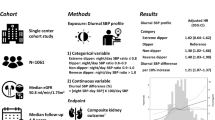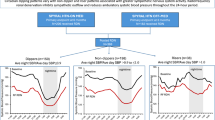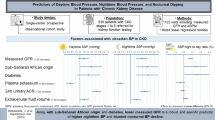Abstract
Study design:
Retrospective study.
Objectives:
To quantify diurnal blood pressure (BP) patterns and nocturnal hypertension and to measure diurnal urine production in spinal cord injury (SCI) patients with clinically significant disorders of BP control.
Setting:
A specialist state-based spinal cord service in Victoria, Australia.
Methods:
Medical records of patients with traumatic SCI who were referred to a specialist service for management of a BP disorder were examined. Ambulatory BP and nocturnal urine production were compared between groups of patients classified according to level, completeness and chronicity of SCI. Patients with night:day systolic BP <90% were classified as dippers, 90–100% as non-dippers and >100% as reversed dippers.
Results:
Patients (44 tetraplegic, 10 paraplegic) were predominantly males (92.6%) aged 41±2.5 years (mean±s.e.m.). Referral was for orthostatic intolerance (n=37), autonomic dysreflexia (n=6), nocturnal polyuria (n=4), elevated BP (n=1) and peripheral oedema (n=1). The average BP was 111.1±1.4/65.0±1.2 mm Hg. In 56% of patients (n=30), BP at night was higher than during the day and another 37% (n=20) were non-dippers. Nocturnal hypertension was present in 31% (n=17) of the patients. In the tetraplegic patients, urine flow rate was greater during the night than day (121±9.5 ml h−1 vs 89±8.2 ml h−1, P=0.025).
Conclusion:
Ambulatory BP monitoring in patients with SCI and clinically significant BP disorders detected a high incidence of reversed dipping and nocturnal hypertension. We postulate elevated nocturnal BP may contribute to nocturnal diuresis that might cause relative volume depletion and thereby contribute to daytime orthostatic hypotension.
Similar content being viewed by others
Log in or create a free account to read this content
Gain free access to this article, as well as selected content from this journal and more on nature.com
or
References
Head GA, McGrath BP, Mihailidou AS, Nelson MR, Schlaich MP, Stowasser M et al. Ambulatory blood pressure monitoring in Australia: 2011 consensus position statement. J Hypertens 2011; 30: 253–266.
Ejaz AA, Kazory A, Heinig ME . 24-hour blood pressure monitoring in the evaluation of supine hypertension and orthostatic hypotension. J Clin Hypertens (Greenwich) 2007; 9: 952–955.
Mathias CJ . Orthostatic hypotension and paroxysmal hypertension in humans with high spinal cord injury. Prog Brain Res 2006; 152: 231–243.
Omboni S, Smit AA, van Lieshout JJ, Settels JJ, Langewouters GJ, Wieling W . Mechanisms underlying the impairment in orthostatic tolerance after nocturnal recumbency in patients with autonomic failure. Clin Sci (Lond) 2001; 101: 609–618.
Okamoto LE, Gamboa A, Shibao C, Black BK, Diedrich A, Raj SR et al. Nocturnal blood pressure dipping in the hypertension of autonomic failure. Hypertension 2009; 53: 363–369.
Hubli M, Krassioukov AV . Ambulatory blood pressure monitoring in spinal cord injury: clinical practicability. J Neurotrauma 2014; 31: 789–797.
Munakata M, Kameyama J, Kanazawa M, Nunokawa T, Moriai N, Yoshinaga K . Circadian blood pressure rhythm in patients with higher and lower spinal cord injury: simultaneous evaluation of autonomic nervous activity and physical activity. J Hypertens 1997; 15: 1745–1749.
Nitsche B, Perschak H, Curt A, Dietz V . Loss of circadian blood pressure variation in complete tetraplegia. J Hum Hypertens 1996; 10: 311–317.
Krum H, Louis WJ, Brown DJ, Jackman GP, Howes LG . Diurnal blood pressure variation in quadriplegic chronic spinal cord injury patients. Clin Sci 1991; 80: 271–276.
Ohkubo T, Imai Y, Tsuji I, Nagai K, Watanabe N, Minami N et al. Relation between nocturnal decline in blood pressure and mortality. The Ohasama Study. Am J Hypertens 1997; 10: 1201–1207.
Cannon A, Carter P, McConnell A, Abrams P . Desmopressin in the treatment of nocturnal polyuria in the male. BJU Int 1999; 84: 20–24.
Mann S, Altman D, Raftery E, Bannister R . Circadian variation of blood pressure in autonomic failure. Circulation 1983; 68: 477–483.
Sommer S, Aral-Becher B, Jost W . Nondipping in Parkinson’s disease. Parkinsons Dis 2011; 2011: 897586.
Mathias CJ . Autonomic dysfunction and hypotension. In Willerson JT, Wellens HJ, Cohn JN, Holmes DR (eds). Cardiovascular Medicine, 3rd edn, Springer: London, UK. 2007, pp 1883–1910.
Jordan J, Shannon JR, Pohar B, Paranjape SY, Robertson D, Robertson RM et al. Contrasting effects of vasodilators on blood pressure and sodium balance in the hypertension of autonomic failure. J Am Soc Nephrol 1999; 10: 35–42.
Shannon J, Jordan J, Costa F, Robertson RM, Biaggioni I . The hypertension of autonomic failure and its treatment. Hypertension 1997; 30: 1062–1067.
Shibao C, Gamboa A, Abraham R, Raj SR, Diedrich A, Black B et al. Clonidine for the treatment of supine hypertension and pressure natriuresis in autonomic failure. Hypertension 2006; 47: 522–526.
Lee C-S, Lu Y-H, Lee S-T, Lin C-C, Ding H-J . Evaluating the prevalence of silent coronary artery disease in asymptomatic patients with spinal cord injury. Int Heart J 2006; 47: 325–330.
Hoshide S . Associations between nondipping of nocturnal blood pressure decrease and cardiovascular target organ damage in strictly selected community-dwelling normotensives. Am J Hypertens 2003; 16: 434–438.
Boggia J, Li Y, Thijs L, Hansen TW, Kikuya M, Björklund-Bodegård K et al. Prognostic accuracy of day versus night ambulatory blood pressure: a cohort study. Lancet 2007; 370: 1219–1229.
Fagard RH, Thijs L, Staessen JA, Clement DL, De Buyzere ML, De Bacquer DA . Prognostic significance of ambulatory blood pressure in hypertensive patients with history of cardiovascular disease. Blood Press Monit 2008; 13: 325–332.
Curt A, Nitsche B, Rodic B, Schurch B, Dietz V . Assessment of autonomic dysreflexia in patients with spinal cord injury. J Neurol Neurosurg Psychiatry 1997; 62: 473–477.
Acknowledgements
This research was supported by a grant from the Transport Accident Commission (DP174). MYG is supported by a scholarship and stipend through the University of Melbourne and Spinal Research Institute.
Author information
Authors and Affiliations
Corresponding author
Ethics declarations
Competing interests
The authors declare no conflict of interest.
Rights and permissions
About this article
Cite this article
Goh, M., Wong, E., Millard, M. et al. A retrospective review of the ambulatory blood pressure patterns and diurnal urine production in subgroups of spinal cord injured patients. Spinal Cord 53, 49–53 (2015). https://doi.org/10.1038/sc.2014.192
Received:
Revised:
Accepted:
Published:
Issue date:
DOI: https://doi.org/10.1038/sc.2014.192
This article is cited by
-
Quantitative analysis of dysautonomia in patients with autonomic dysreflexia
Journal of Neurology (2021)
-
Relationship between autonomic cardiovascular control and obstructive sleep apnoea in persons with spinal cord injury: a retrospective study
Spinal Cord Series and Cases (2018)
-
Diurnal blood pressure and urine production in acute spinal cord injury compared with controls
Spinal Cord (2017)
-
Sleep-Disordered Breathing and Spinal Cord Injury: Challenges and Opportunities
Current Sleep Medicine Reports (2017)
-
A retrospective review of sleep-disordered breathing, hypertenstion and cardiovascular diseases in spinal cord injury patients
Spinal Cord (2015)



